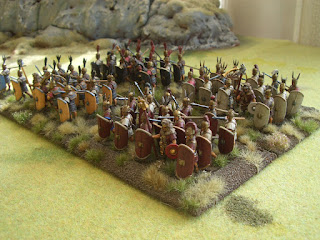After a year spent painting Romans & their Italian cohorts I'm having a well deserved break & heading forward in time 1800 years to Stuart era England & scene of my first ever foray into 25/28mm wargaming some 30 years ago.
In anticipation of some actual gaming I've started to update the bases of my English Civil War collection, starting with the titular 'Shrewsbury Foote'
Before getting to the photos it might be useful to explain the origins of this unit:
As part of the Royalist recruiting drive in 1643 various units of the English army in Ireland were shipped back to the mainland disembarking at various ports along the Welsh coast & in the West country in late 1643 & early 1644, the units that concern us are as follows:
Col. Fulk Hunckes
Col. Wm. Gibson all arriving 1643
Col. Henry Warren
Col. Robert Broughton
Col. Henry Tillier arriving early 1644
The first group of regiments served at the Siege & Battle of Nantwich as part of Lord Byrons army & thereafter with Broughtons & Tilliers in Prince Rupert's 1644 Northern campaign, culminating in the Royalist defeat at Marston Moor. It was after this disaster that the remnants of these units were brigaded together as The Shrewsbury Foote.
They continued to serve the Royalist cause under a Colonel Smith ( Broughton & Tillier both being captured at Marston Moor) and are noted as being 500 strong at the battle of Naseby in 1645. After that setback the remnants of the unit were dispersed into various garrisons in Shropshire but they did have a last hurrah at the battle of Stow on the Wold in 1646. Not the most successful of military experiences, but one typical of many Royalist regiments from 1643 onwards.
As far as dress & equipment goes I've managed over the years to find a few reliable details:
Col.Tilliers. Green coats ( noted in aletter from Dallison to Prince Rupert), no info on colours but there is a letter somewhere that mentions them flying strips of green taffeta at one muster in 1645.
Col. Broughtons. Often attributed as wearing green coats, based on a correspondence noting a green coated brigade at the last stand following Marston Moor, Tilliers are known to have been present & the assumption is that Broughton's were the other regiment brigaded with them.
Colours may have been blue ( device unknown) but it escapes me where I read this snippet of info.
Col. Warrens. Red coats & noted as carrying red & white colours in Ireland, no info on what form these took however ( gyronny, red with white devices, stripy?) & whether the practice was continued in England.
I've not found any information on coats & colours for Gibson's & Hunckes's but it is noted that the first group of regiments were re-equiped with civilian clothes on their arrival in Wales in 1643 so for the campaign in the north west they would have presented a motley spectacle.
History lesson over, onto the pictures:
 |
| This more uniformly equipped unit of musketeers are Tyldesley's Regt, late of the Oxford army. |
 |
| As noted above Warren's Regt. may have used red colours, the use of white balls is pure artistic licence. |
 |
| Historical note: the pikeman in the fetching red britches is supposed to be me, a hangover from my days in the Sealed Knot. |
The miniatures are all Redoubt Enterprises & Renegade. More to follow soon.





















































